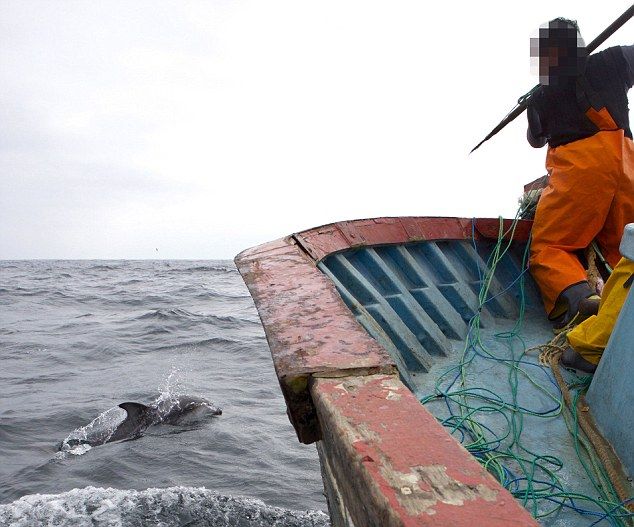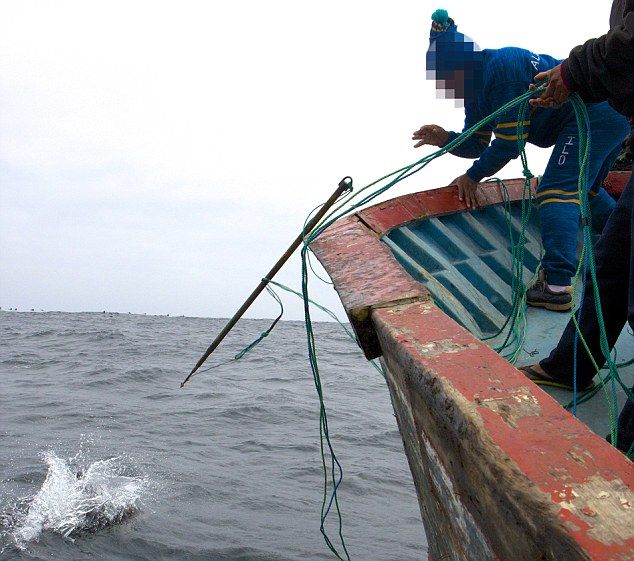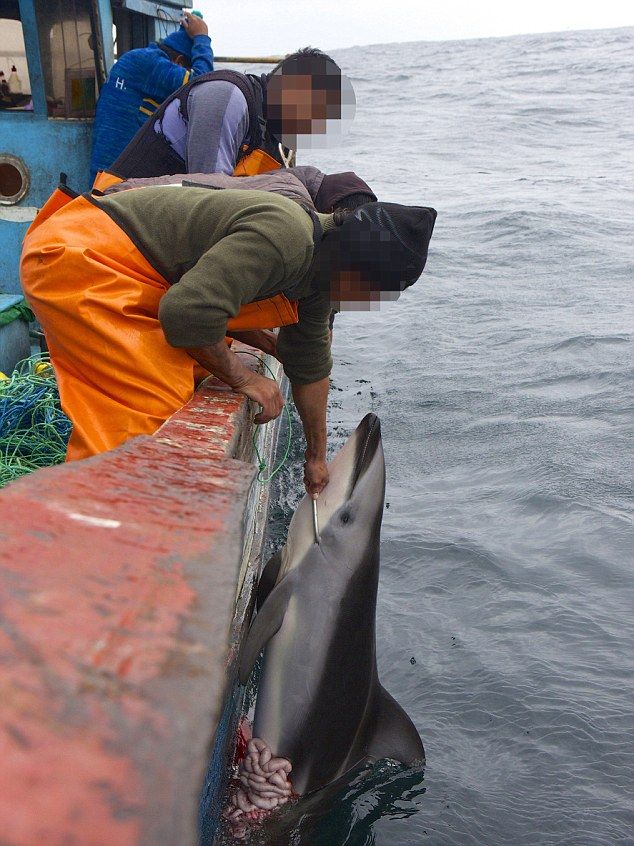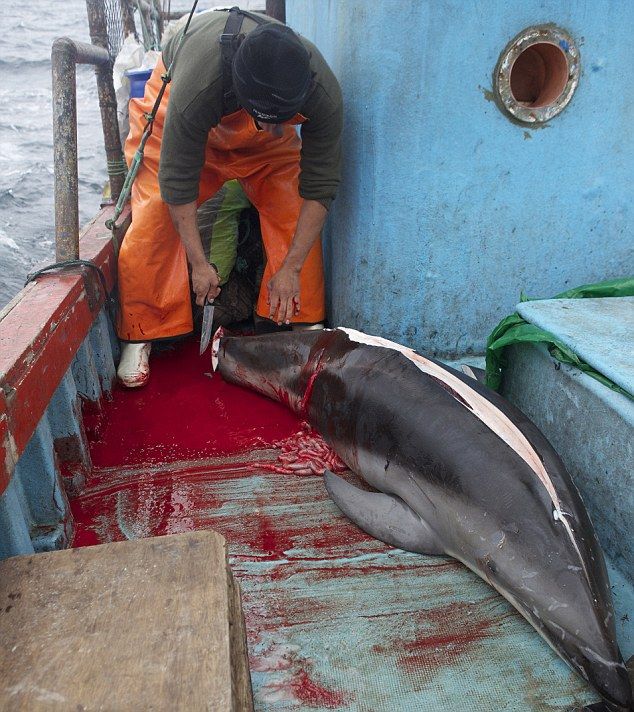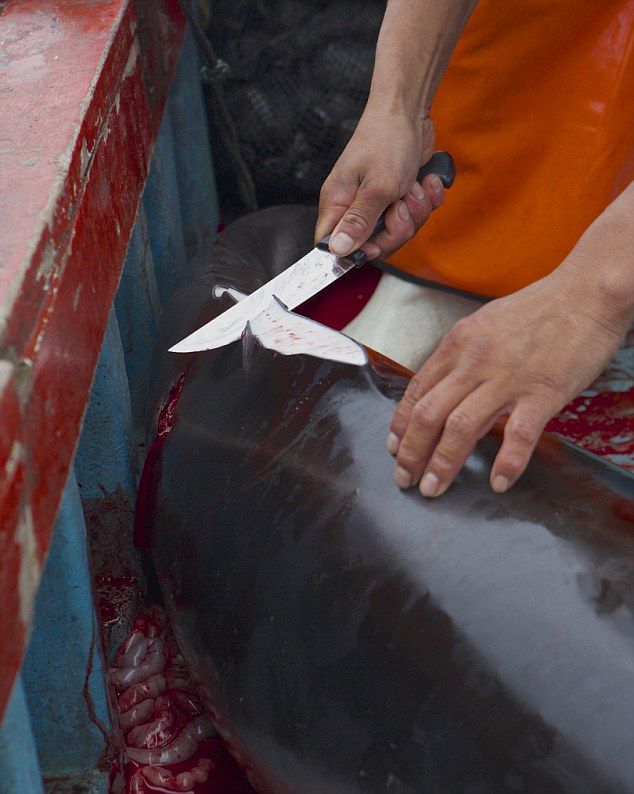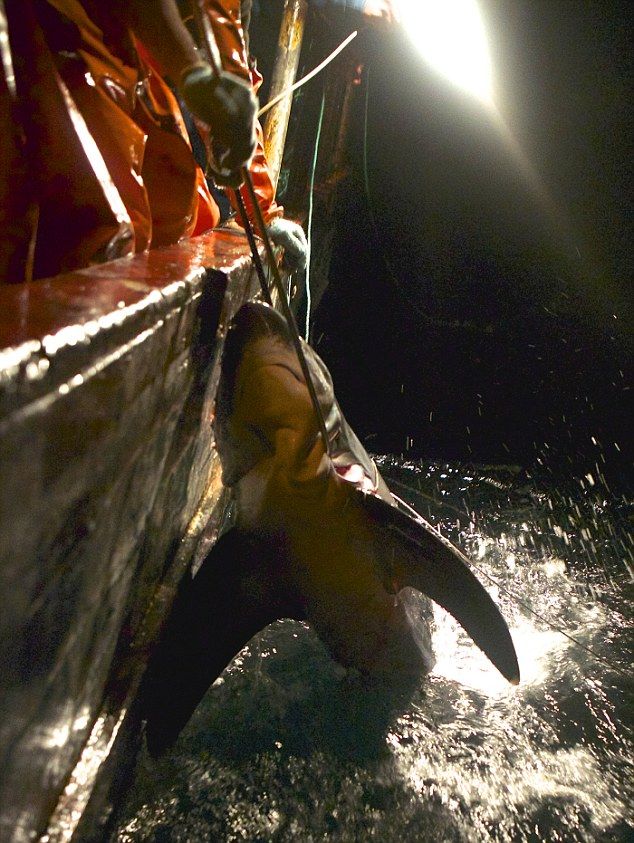As our vessel cut through the Pacific waves, the dolphins tucked themselves under the bow, taking it in turns to playfully surf the wake.
In any other circumstances, it would have been a beautiful sight. But now I could hardly bear to watch, sick to my stomach at the prospect of what was about to happen.
For up above the dolphins, on the deck of the Peruvian fishing boat, stood its captain, brandishing a razor-sharp harpoon.
He steadied himself, carefully watching the rhythm of the dolphins as they surfaced for air. There was a momentary pause... and then he struck, hurling 30kg of tubular steel into the dolphin’s back as it swam alongside.
As the harpoon sliced through the dolphin’s flesh, a cry of excitement went up from the crew as they celebrated their catch.
Our cameraman Ale and I watched in horror as the rope attached to the harpoon snaked away from the boat.
Fifty yards away, the dolphin’s beak broke the surface as it struggled to escape the line, slowly tiring as it became enveloped in a thick cloud of its own blood.
Two crewmen dragged the rope in, the dolphin still desperately thrashing, but there was to be no miracle escape.
As the dying animal neared the boat, a shiny steel hook was plunged into its head and it was hauled aboard, intestines pouring out of the wound where the harpoon had gone clean through.
The body was still twitching.
A crew member sharpened a knife and casually began to slice off the fins, tossing them into the sea.
As the thick puddle of bright red blood widened, he began to peel the skin off its back.
The hunt was over, the dolphin dead, the fishermen had their bait.
With the excitement temporarily at an end, the crew were quickly back into their normal routine.
The salsa music went back on the wheelhouse stereo and a cry from the cook announced that lunch was ready.
A crew member handed me a bowl of soup but as I crouched on the deck next to the skinless carcass of an animal that only a few moments earlier had been effortlessly racing through the ocean waves, I vomited.
I looked at Ale and saw the same look of nauseous horror on his face but we both knew we could say nothing.
We were 100km off shore, surrounded by fishermen who regarded what we had just seen as entirely normal: to say anything about the killing or to be seen portraying any negative emotion could be very dangerous.
But at least we had finally witnessed what we had come to see. We had concrete proof of what, until now, had only been rumour: namely that thousands of dolphins are being killed by Peruvian fishermen who then cut them up and use them as bait for shark fishing.
In marine conservation terms, that’s a double catastrophe, with dolphins — many species of which are protected — being killed to catch sharks, many species of which are now endangered.
It is thought to be the world’s biggest dolphin slaughter and, as an investigative environmental journalist, I was determined to see it for myself.
I secured the bulk of my funding from the Pulitzer Centre for Crisis Reporting, an American organisation, and set about trying to arrange a trip.
After months of patient negotiation, I’d found a skipper willing to take us in exchange for a contribution for fuel and the strict promise of anonymity.
The Peruvian fishermen call dolphins ‘sea-pigs’. It’s a term that does no justice to their elegant movement through the water but, from the fishermen’s point of view, is perhaps a not unreasonable description of an animal that supplies meat that seems tailor-made for shark fishing.
With its rich blood supply, sharks are instantly attracted to fresh dolphin meat and, best of all, unlike other shark bait it’s absolutely free.
So on our third day out of port, my heart sank when I heard the skipper’s excited cry of ‘chenchos!’ - ‘fat pigs’ - and we saw half a dozen dolphins break away from feeding on the anchovy shoals that the nutrient-rich Peruvian waters support in such abundance and race towards the boat to ride our bow-wave.
It should have been a moment to gladden the heart but ours were heavy.
As the captain stood poised with his harpoon, Ale and I leapt into position to film. It wasn’t enough to see the dolphin killed with our own eyes, we had to have a permanent record that we could take back and show to the world.
But there was more killing to come. By dawn the next day, we had arrived at the fishing ground, a thin sliver on the chart where the water temperature was just right for sharks.
The decks had been hosed down and, in the corner, the dolphin carcass lay flensed - stripped of skin - a long section of flesh sliced out of it.
Two crew members were now chopping it into long slivers, tossing each piece into the bait box alongside the expensive salted mackerel that had been bought for the same purpose.
The captain was very honest about the benefits of dolphin bait. ‘Dolphin meat is effective for the blue shark,’ he says. ‘When you cut it, it bleeds a lot. And the blue shark likes fat, and the dolphin is pure fat.
‘I understand that to hunt the dolphin is illegal. But for me, it’s a necessity, I do it to keep my bills down. I can minimise my costs, because the bait for shark is very expensive. The majority of boats that fish shark carry the spear-gun with the spear ready to use.’
He said he would normally kill two to three dolphins per trip and make 12 trips a year but, with 500 shark boats in Peru at the last count, that suggests expert estimates of 10,000 dolphins being killed by Peruvian fishermen every year could be an understatement.
The meat of the sharks is sold to dealers waiting at the harbour and is destined for dinner plates across the world. The shark fins are sent to the Far East for soup.
In the stern of our 40ft fishing boat, two crew-members crouched, carefully skewering dolphin flesh and mackerel on to hooks on the fishing line. A buoy was dropped in the water and, as the boat chugged slowly away from it, the line was fed out behind it.
Two hours later and the hooks — a thousand of them — were spread out in the water. Now all the crew could do was wait and try to get some sleep, knowing they had a busy night ahead of them.
As the sun set and the temperature dropped, they donned water-proofs and wellington boots and drank soup enriched with maca, an energy-giving Peruvian root.
Then it was time to haul in the catch. Ale and I watched in the darkness, cameras ready, as the fishing line was carefully picked up and coiled by the crew. And then suddenly there was a shout.
The engine slowed and a spotlight shone down into the dark waters below. A svelte, silvery-blue shape gradually appeared in the water.
It was our first shark. Swimming in its normal underwater habitat, the blue shark is a beautiful sight, its tubular torso and wide eyes endowing it with a gentle elegance.
But there was nothing elegant about this one. Hooked and already half-drowned — sharks have to keep swimming to stay alive — it appeared almost drunk, lazily kicking away at the line that now drew it to the boat.
Within seconds, it was hauled over the gunwale and slammed on to the decks, thrashing around. And then the crew fell upon it. One sliced off its entire snout, just in front of its soft white eyes.
Into the gaping hole, a long thin rod was rapidly inserted down the shark’s spinal column and, at last, the thrashing stopped. Its belly was cut open, the insides washed over the side and the shark carcass tossed to the leeward side of the deck.
It would be the first of a dozen sharks the boat would catch, kill and butcher that night.
An hour in, the engine slowed again amid excited shouts from the deck hands. All four men dropped their work to help haul in the line.
Slowly, a vast black shape emerged from the depths. It was a fully-grown thresher shark, a species recently classified as vulnerable to extinction.
Several hundred kilos in weight, its characteristically elongated tail fin alone was 6 ft long.
For a moment or two longer, it was still a beautiful marine creature and then the knives flashed and it joined the growing pile of meat.
But there was worse still to come. Another blue shark was dragged to the surface, still thrashing in the water. When its belly was opened up, dozens of perfectly formed baby sharks slid out, writhing on the deck.
This was too much for Ale and me. Having sat back for days, not interfering and saying nothing, we had to do something. We waved at the crew, pleading with them to put the live baby sharks in the sea.
They laughed — the idea was comical to them — but they did round up the baby sharks and toss them over the side.
The beam of a torch revealed the tiny fishes’ first clumsy movements in the ocean. The odds on them surviving were slim but at least they now had a chance.
It was 5am. Exhausted by the killing and no longer able to trust myself, I left a deck covered in blood, writhing sharks and savage hooks and descended to the cabin. In every sense, I’d had — and seen — enough.
